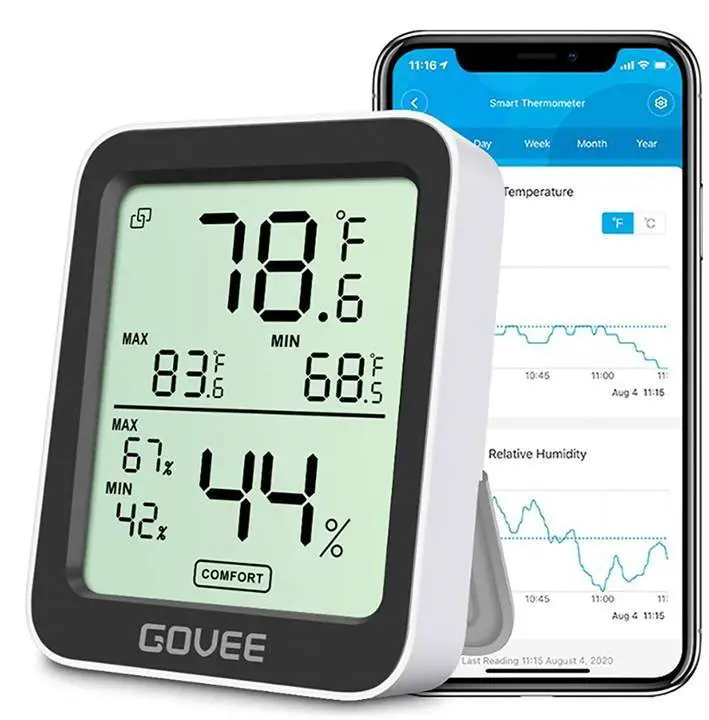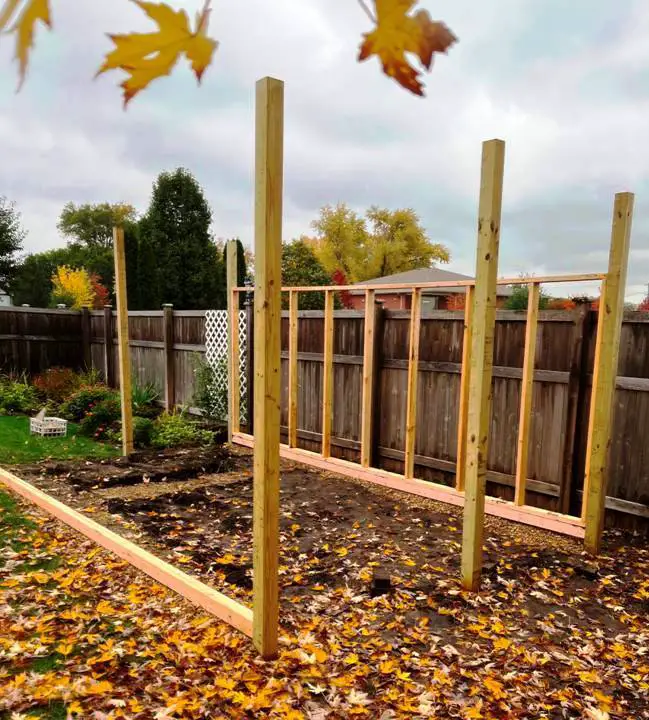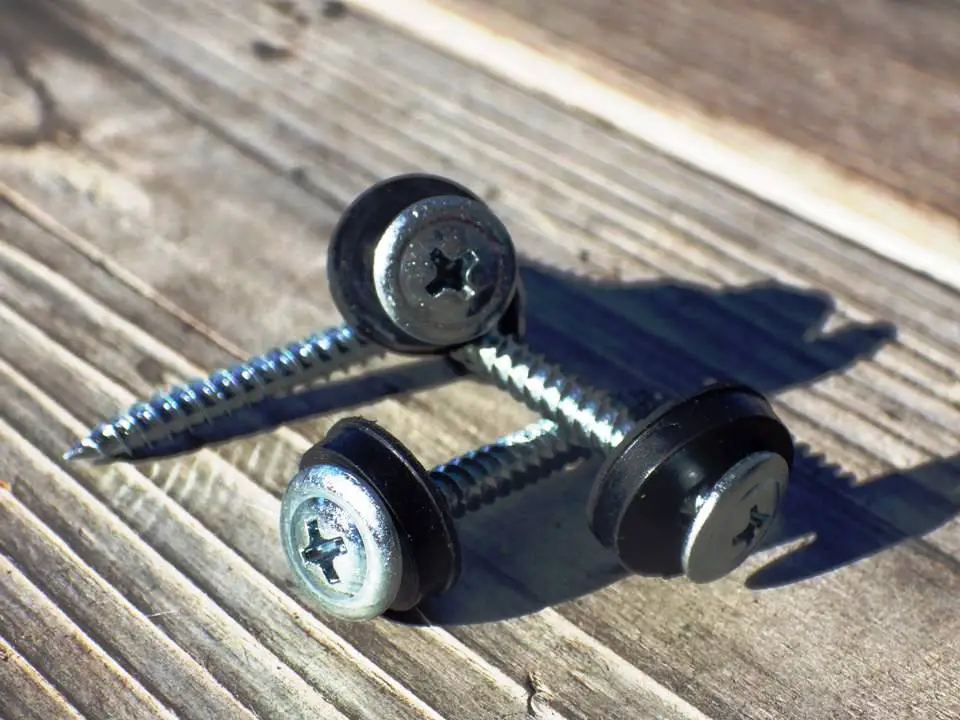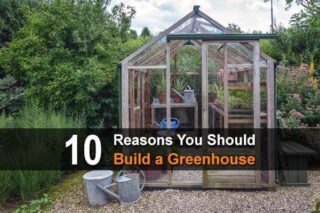Estimated reading time: 25 minutes
If you’re ever had it in the back of your mind that you’d like a greenhouse, you really should think about putting one together. There are numerous options from simple to complex and they can not only give you a head start on the growing season, but even allow you to grow plants all year round.
We’ll cover the greenhouse basics and even how to keep one going through the winter. Then we’ll roll up our sleeves and build a greenhouse with lumber from the ground up.
Want to save this post for later? Click Here to Pin It On Pinterest!
Pick Your Size

The size of your greenhouse depends a lot on how much available space you have on your property, and your motivation to make a greenhouse a part of your gardening.
Small greenhouses that measure about 2×4 feet can be bought at a home center or online and erected in an hour.
Larger greenhouses with a metal frame and plastic panels are also a possibility in sizes from 3×6 feet up to 8×12 feet.
If you have some basic construction skills you can even buy your own lumber and build a larger greenhouse. The greenhouse we built was 10×16 and constructed from 2×4’s and 4×4’s.
Greenhouse Walls and Roof

What makes a greenhouse work is that the walls and roof are transparent. Sunlight powers a greenhouse to not only provide sunlight to plants but to capture and hold heat. How well your greenhouse holds heat depends a lot on the type of transparent material you choose, but even 6mil plastic will retain heat except in the dead of winter.
Wall and Roof Options
- Polycarbonate Plastic Panels

A common reference to greenhouse wall and roof coverings are something called “polycarbonate panels.” These are sheets of hard plastic with ribs holding together two sheets of plastic to create an air gap in the sheet. The thickness of the sheets varies from an eighth of an inch to quarter-inch and even half inch. They can be used on the roof and the sides.
They are available in 2×4 foot panels and can also be purchased as 4×8 foot panels and 2×8 foot panels. The larger and thicker the panel –the higher the cost. For our greenhouse we used 2×4 root panels 1/8th of an inch thick.
- Rippled Plastic

Rippled plastic sheeting is another popular option for greenhouses. They’re usually sold in 2×8 foot sheets and are transparent with a regular ripple to provide rigidity. They’re also used on the roof and the sides and are also made of polycarbonate plastic.
- 6 or 10 mil Plastic Sheets in Rolls

This is a very popular option for its low cost and durability. It’s also very easy to attach to a greenhouse in a variety of ways. Better yet, it’s easy to repair or replace.
For our greenhouse we used polycarbonate sheets for the roof and 6mil plastic sheeting for the sides and door. What you use and how much you spend is up to you as long as it’s transparent.
Double Wall Insulating

If you live in a northern latitude and want to use your greenhouse year round you can apply a double wall of sheeting. This is easy to do with a wood frame construction and all it involves is applying polycarbonate sheeting or plastic sheeting both outside and inside the frame. It creates a layer of air that provides additional insulation from the cold.
Some double wall greenhouses actually inflate the two walls with circulating air to ensure the cold stays out. We’ll include a list of links to a variety of sites and videos that cover many of the variations and ideas we’ll cover.
Ventilation

One of the things that makes a greenhouse effective is to make it airtight. That means there are no unintentional leaks, gaps, holes or other ways that air can get in or out of the greenhouse.
The bad news is that a greenhouse can get surprisingly hot, especially in summer. High heat can kill plants as fast as extreme cold. As a result, windows and even exhaust fans are common and necessary particularly in larger greenhouses.
Like so many things there are all sorts of very complicated ways to do this. We kept it simple with our greenhouse installing a small shed window (cost about $40), two solar powered fans and a large and upcycled antique window on the side.
The solar fans cost about $40 and the antique window was salvaged.

The door can also allow for easy and quick ventilation but you may need a small j-hook to keep it open on a windy day.
Moisture and Humidity

Another factor that makes a greenhouse highly effective for plant growth and health is its ability to hold and retain moisture. But once again, there is such a thing as too much. Excess and constant high humidity can encourage the growth of fungus and mold. That’s where the solar fans can help but how do you know when the humidity is too high.
Thermometer/Hygrometer Gauges

You can buy a combination thermometer / hygrometer gauge to help you assess the temperature and humidity in your greenhouse. Better yet, some of them allow you Bluetooth access on your cell phone so you can easily monitor conditions in your greenhouse anywhere at any time.
The ideal humidity level in a greenhouse is usually 65 to 75% at night and around 80% during the day. Any level above or below that range can disrupt the physiological processes in many plants resulting in slower growth. Very high humidity about 80% can also lead to blooms of fungus on leaves.
The ideal temperature level for greenhouses is 65 to 75 degrees Fahrenheit. How well any plant can tolerate temperatures above or below that range depends on the type of plant but on average that range is ideal. Exceptions would apply to plants that are uniquely tropical or highly tolerant of colder temperatures, but most greenhouses have a diverse collection of plants so it makes sense to follow the averages.
There are exhaust fans that can be programmed to automatically turn on when a preset temperature or humidity level gets too high.
Consider a Rain Barrel Collection System

Most greenhouses have conventional, slanting roofs that make rain water collection a possibility. Hoop framed greenhouse are a bit of a challenge for rain water collection but a slanting roof can drain the water into small gutters and channel it to funnels where the rain water can be directed into a rain barrel.
There are a surprising number of benefits to having a rain water collection system on a greenhouse and having the barrel inside:
- A rain barrel inside will warm up from the sun’s rays during the day and radiate any stored heat into the greenhouse during the cooler, nighttime temperatures. A black barrel will collect the most heat.
- A rain barrel inside the greenhouse will give you easy access to water either with a hose hooked up to the bottom of the barrel or to simply fill a watering can.
- Rain water is very pure water and a favorite of plants. There are no chemicals like chlorine in the water and no minerals that can leave a dry residue on the leaves.
- Rain water is free and that can really help if you have a monthly water bill from a municipal water source.
Plants Racks, Tables and Greenhouse Organization

How you organize the inside of your greenhouse is up to you but there are a few things to keep in mind as you add shelves, tables and plants.
- Racks, tables and plants all cast shadows. Try to stage your shelves, racks and anything in your greenhouse so taller objects are on the north side where their shadows will be cast to the outside allowing maximum sunlight to all parts of the greenhouse.
- Figure out where you will put your potting station. This is where you will care for plants by repotting, filling with soil, pruning and general care. A corner on the north side that receives the least sun is a good possibility because you usually don’t keep a lot of plants on a potting table for any length of time.
- Don’t forget that you can hang potted plants from your greenhouse ceiling but here again, keep an eye on location so you don’t create too many shadows across your greenhouse. Generally, the higher you can hang the plants -the better.
- If you have a rain collection barrel, try to locate it against a wall that gets a good amount of exposure to sunlight so you can ensure the radiant heat action of the barrel at night. The northwest corner is a possibility, or the middle of the west side where the warm afternoon and early evening sunlight will shine.
- Other than your potting table and water barrel you can move stuff around as your greenhouse evolves. This will also occur as the season progresses and you move things into and out of the greenhouse.
Passive, Off-Grid Heating Options for a Greenhouse

You could always heat your greenhouse in winter with a space heater but most of them run at either 750 or 1500 watts. That’s going to put a real dent in your electric bill. Unless you live in an exceptionally cold climate and really need your greenhouse all year round, you should consider some other ways to keep a greenhouse warm in winter.
- Insulation is the first step and that begins with making sure you don’t have any air leaks, holes, rips or gaps in the walls or roof of your greenhouse. It’s like a house and air leaks will constantly cause your greenhouse to lose heat. Your windows and fans can vent your greenhouse when you need it, but you want it to be an option not a constant leak.
- We already mentioned the water barrel idea for radiated heat overnight. Dark colored barrels absorb more heat from the sun and black is best. If you find this really works for you, one possibility is to add another barrel. Some greenhouses have multiple water barrels with water draining from one barrel into the next.
- There are various designs for terra cotta heaters using candles. These are the standard flower pot heater that you may have heard about using tea candles under terra cotta flower pots to create heat on especially cold nights. There are a variety of ways to design and build these and we’ll list them in the link section at the end of this article.
- Other black objects in a greenhouse will also collect and hold heat. Possibilities include black boulders, black rocks on the floor, black flower pots, black surfaces on tables and shelves. If it’s dark and especially black it will absorb a lot of heat. This can create the opposite problem in summer, so think about dark objects that you can switch out or change in some way to prevent your greenhouse from turning into a furnace in summer.
- Heat from a compost heap is another possibility. Some people just build a compost heap in the corner of their greenhouse and let it decompose and create heat. Other variations involve metal piping running from the compost heap outside and into the greenhouse to bring the heat inside. We’ll cover links to those options as well as some others at the end of the article.
- Finally, think about the plants you plan to keep in your greenhouse over the winter. It doesn’t make a lot of sense to fill a winter greenhouse with a lot of tropical plants. Keep an eye on plant hardiness as you plan for winter and the colder days of early spring and late fall.
And Then There’s the Floor

Many people simply have a dirt floor in their greenhouses. The roof protects it from rain but a lot of watering happens in a greenhouse so mud is inevitable on a dirt floor. Then again, some greenhouses have effectively used moss on the floor. That assumes you can find enough moss to cover the floor. Here are some other options to consider:
- Stone is a common option in many greenhouses. The stones allow any excess water to drain but keeps your feet above the mud although too much mud could cause the stones to sink.
- Bricks are a great option but can be expensive. Recycle or upcycled bricks from a local demolition is good idea. It will give your greenhouse floor a very rustic appearance but what better place for that than a greenhouse?
- Boards or even boardwalks are another possibility. If it keeps you out of the mud –it works.
- And then there’s old tiles. How many of us find boxes of old tiles in the basement and throw them out? It’s another great way to stay out of the mud for no cost. And if you don’t have any old tiles sitting around, ask around with friends and see if they have any they don’t want.
Constructing a Wood Frame Greenhouse

We built a 10X16 foot wood frame greenhouse using polycarbonate sheets for the roof and plastic sheeting for the sides.

We used 2×4’s for the walls and roof, 4×4’s for the foundation and main support posts, and 1×2’s to hold the plastic in place. We also used greenhouse tape 1-inches and 6-inches wide to tape together critical seams and help waterproof everything.

We’ll go through the process step by step. Our long-term plan is to replace the plastic sheeting on the sidewalls with more polycarbonate sheets at a later date but using the plastic sheeting helped us keep our initial cost down.
Materials:
- 2 16-foot 4×4’s
- 2 12-foot 4×4’s
- 6 10-foot 4×4’s
- 1 16-foot 2×6
- 2 16-foot 2×4’s
- 52 8-foot 2×4’s
- 4 8-foot 2×2’s
- 34 8-foot 1×2’s
- 1 16-foot 2×12
- 300 3-inch wood screws
- 50 4-inch wood screws
- 3 bags of concrete
- 24 2×4 polycarbonate roof panels
- 40 x 50 feet of 6 mil plastic sheeting
- 72 1-inch lathe screws with rubber washers (for attaching polycarbonate roof panels)
Construction
1. Stake out a 16 x 10 foot rectangle
Make sure the stakes are centered and the rectangle is squared at the corners. Aslo add a stake at the ends in the center for your main support posts. Run some string from stake to stake to define the final shape and perimeter of your greenhouse. If you need to, clear and level the ground.
2. Dig 6 Post Holes 2-feet deep
Dig 6 post holes where your stakes are located. Ideally they should be 2-feet deep.
3. Position 10 foot 4×4’s in the holes

Fill your holes with about 2 to 3 inches of stone and then drop a 10 foot 4x4s into each hole. File each hole with dry concrete and continue to move the posts to a vertical position allowing the dry concrete to keep them in place.
The use of a post level will ensure your posts are perfectly straight. Having a couple of them on hand will allow you to easily check that they are perfectly vertical.
Add water to each hole and work the concrete around with a spade. This will allow the water and concrete to percolate into the stone at the bottom and totally surround the post with concrete. Try to get a good mix of concrete and water so you have a thick concrete batter. Level the top of the concrete with a trowel to the surface of the soil.
4. Attach the 4×4 foundation to the posts

After 24 hours the concrete should be set. Add your 4×4 foundation posts to the bottom of the greenhouse. Attach them to the vertical 4×4’s and make sure they are level all around. Shovel stone under any gaps between the length of any 4×4 and the ground.
5. Build the first 16 foot wall

Using 2 of your 16 foot 2×4’s, build your first wall with the 8-foot 2×4’s spaced 24-inches on center. That 2 foot gap will allow you to easily add 2×4 foot polycarbonate sheets either at the beginning of construction or at a later time.
The height of your walls is up to you. We cut our 8-foot 2×4’s down to 6 and a ½ feet for our wall height. You should also measure the exact distance between your two corner posts. They will rarely be exactly 16 feet apart and you may need to trim an inch or two off of your 16 foot 2x4s for the top and bottom of your wall.
Assemble the wall using 3-inch screws and then install the wall on top of your foundation 4×4 and flush with your 4×4 posts. Attach the wall to the posts on the sides and bottom with 4-inch screws.
6. Build the second 16 foot wall

Build the opposite wall the same way and attach it to the 4×4’s.
7. Build the end wall with window opening

We built two small wall frames for the back end of the greenhouse. We started by measuring the distance from one corner post to the center post and cut the 2×4’s to fit. We put the supporting 2×4’s at 12-inches on center for the end walls.
We built a second end wall but adjusted the vertical 2×4’s to fit the window. Measure any window you’re planning to install and make sure you build the frame to fit. Once built, install the two end walls.
8. Build the opposite end wall with door frame
At the opposite end we built two more walls. One of these front walls included a frame for the door. The door frame was 6 and a half feet high and 36-inches wide to allow us plenty of room to get in and out of the greenhouse with pots, wheelbarrows and other stuff. Once the walls were built they were also attached to the 4×4’s using the 4-inch screws.
9. Attach the 16-foot ridge beam and trim the corner posts

We used metal wood braces to attached the top beam and then used a Sawzall to cut the corner posts flush with the tops of the side walls.
10. Build and attach the door

The door was built using the 2x2s with a brace across the top of the door. We attached the door with hinges and added a handle. We later added insulated padding to keep the door airtight and cabinet door clips to hold the door in place. We also added a simple stick with a screw to keep the door closed.
11. Attach the roof rafters on each side

We cut 4 2×4’s on an angle and attached them to the roof ridge and the 4×4 posts at the corner. Here’s a link to a video that shows you an easy way to determine the angle of your cut for roof rafters.
12. Seal the wood framing with water seal

It would have been nice to buy cedar to build our greenhouse but it was beyond our budget. Instead we used pine lumber but sealed it with a Thompson Water Seal that had a cedar stain. If you seal or stain your greenhouse frame, let it dry for 24 hours.
13. Temporarily remove the door and Attach plastic sheeting to the sides

Now it was time to attach the plastic sheeting. Here are links to a couple of videos that show you some ways to do that. It can be challenging and is best done with two people. Hopefully you don’t have a windy day like we did.
14. Cut out the door opening and reattach the door and install first side of roof rafters

We had to cut through the plastic sheeting for the door opening. We used a razor knife and stapled the sheeting around the door frame 2×4’s. We then started to install the roof rafters to the first side of the roof. We aligned them with the wall studs so they remained 24-inches on center.
15. Attach the roof rafters to the opposite side

We then added the roof rafters to the other side of the roof.
16. Attach polycarbonate panels to roof

We were relieved to see that our spacing was perfect and our polycarbonate panels fit to the center of each 2×4 roof rafter.
We used the lathe screws with a rubber washer to attach the polycarbonate panels but also added a long bead of silicone sealer along the rafter under the polycarbonate to create a gasket.

We then screwed in our lathe screws and as an extra step, ran a 2-inch strip of plastic greenhouse tape down the center of the seam after two panels were butted to each other on each rafter.
17. Attach 2×10 over front

We found that our last rafter opening leading to the front of the greenhouse actually had a gap larger than 2 feet. To compensate we added a 2×10 over the front to act as a small awning over the front and to support the polycarbonate panels. It also gave us a good anchor point for the roof ridge that we added at the end of the build.
18. Install window

We cut out the plastic around our window opening and stapled the plastic to the frame. We then installed our window.
19. Attach roof ridge

You can buy roof ridges or make one yourself from a sheet of 8 to 12 inch wide sheet metal. If you make your own you’ll need to bend the ridge in the center to match the angle of your roof. We did this and then painted it brown to match the color of the framing. We also attached an old, antique window we found in the barn to help with ventilation.
20. Setup Rain Water Collection System

If you’re planning to collect rainwater you can start to setup your rain water collection system. Every custom built greenhouse is a little different but what you’ll basically need are gutters, funnels to collect the water and direct it into a series of pipes that lead to your barrel. Here’s a video about one way to design a rain water collection system.
21. Start Planning Your Interior

Once the exterior of your greenhouse is done you need to make some final decisions about the type of floor and the interior design.
It’s Up to You
Whether or not your buy or build a greenhouse is a personal decision, but if you’re an avid gardener it may be worth giving it a try. Here are links to a range of articles and videos about many of the way to build and maintain a greenhouse:
VIDEOS:
- What I Wish I Knew BEFORE I Got A Greenhouse
- DIY Greenhouse | Don't Buy a Kit Until You See This
- The Secret To Building A 10×12 Greenhouse In One Day
- The Ultimate Guide to DIY Greenhouses: Pros, Cons, and Everything In Between
- Greenhouse Build 16×28
- Greenhouse HEATER Made from Stuff you have
ARTICLES AND PLANS
- 13 Free DIY Greenhouse Plans (By Type of Greenhouse)
- 122 Free DIY Greenhouse Plans to Help You Build One in Your Garden This Weekend
- How to Heat a Greenhouse: 8 Ways
- 7 Innovative Ways To Heat Your Greenhouse In Winter
- How to Build a Rain Capture System for Your Greenhouse
- The Basics of Greenhouse Ventilation
Like this post? Don't Forget to Pin It On Pinterest!
You May Also Like:













Thanks! This was very helpful.